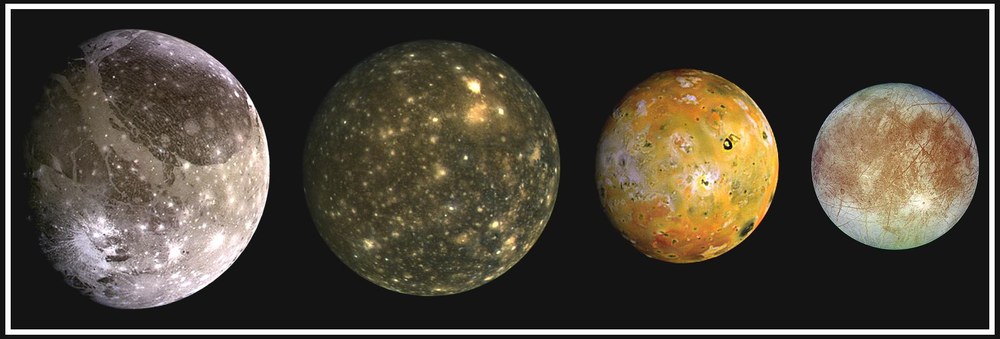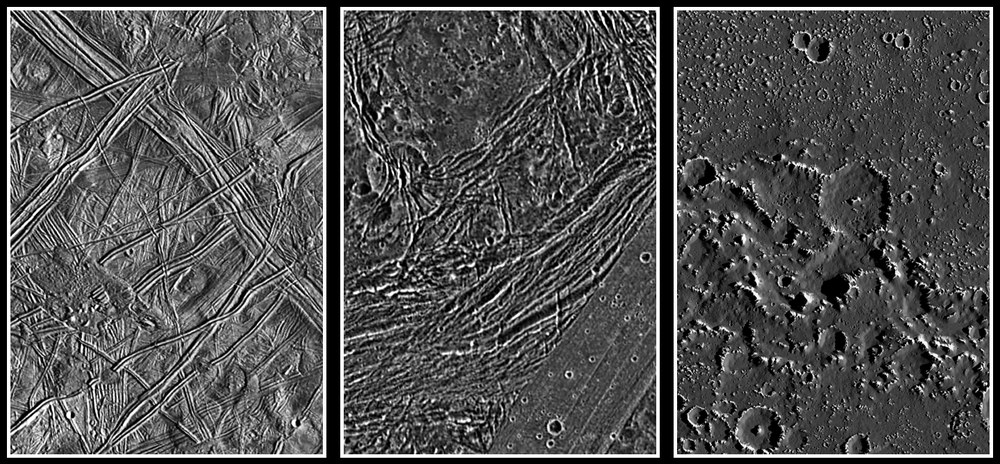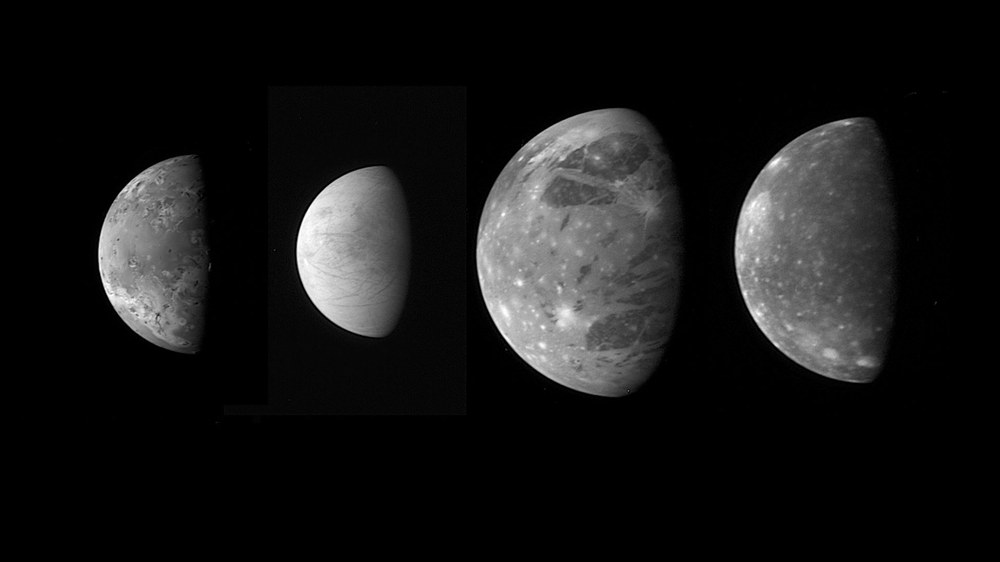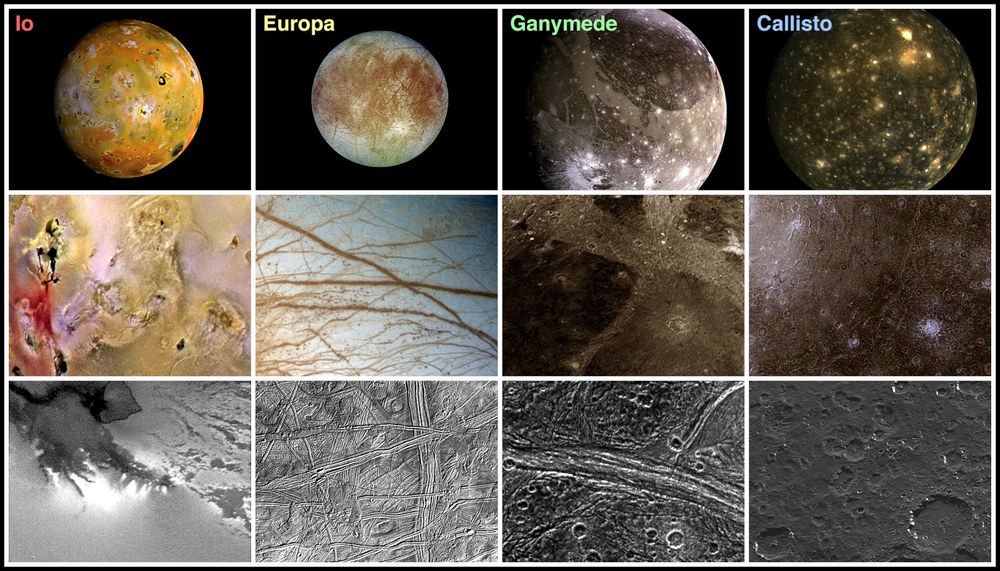The large moons of Jupiter (Galilean moons)

NASA/JPL/DLR


NASA/Johns Hopkins University Applied Physics Laboratory/Southwest Research Institute
There are currently 92 moons known to orbit Jupiter. The four largest – Io, Europa, Ganymede and Callisto – were discovered by Galileo Galilei in 1610 when he pointed the first astronomical telescope at the Moon, Venus and the planet Jupiter in quick succession. They are called Galilean moons in light of his discovery. Galileo realised that there are satellites which, like Earth's moon, orbit another planet in the Solar System. This strengthened his belief that the claim previously published by Nicolaus Copernicus was correct, according to which it was not Earth that lies at the centre of the Universe, but the Sun.
Galilean moons
Io | Europa | Ganymede | Callisto | |
|---|---|---|---|---|
Mass (kilograms) | 8.94 x 1022 | 4.88 x 1022 | 14.82 x 1022 | 10.76 x 1022 |
Radius (kilometres) | 1821.6 | 1560.8 | 2631.2 | 2410.3 |
Density (kilograms per cubic metre) | 3528 | 3013 | 1942 | 1834 |
Orbital period (days) | 1.76 | 3.55 | 7.16 | 16.69 |
Average distance from Jupiter (kilometres) | 421,000 | 670,900 | 1,070,660 | 1,883,000 |

NASA / JPL
Io – high volcanic activity, no ice crust
Io is the closest Galilean moon to Jupiter: its volume, size and density are similar to Earth's Moon. Io orbits Jupiter at an average distance of 442,000 kilometres, which is less than six Jupiter radii. Jupiter's enormous gravitational pull drives tidal action inside Io. This leads to friction, which creates heat. It is many times stronger than the effect our Moon has on Earth’s water masses. In the time taken for Ganymede to complete one orbit of Jupiter, Europa orbits the planet exactly twice and Io exactly four times. This effect arises from the gravitational interactions between Jupiter and the three moons and is known as the 'Laplace resonance'. As a result of this resonance, Io is forced into a slightly elliptical orbit. The resonance and the slightly elliptical orbit amplify the tidal effect, which is maintained over long astronomical periods. As a result, rock melts in the interior and there is very intense volcanic activity on the surface. Unlike its three outer neighbours, Io has no ice crust.
During the Voyager flybys in 1979 and the observations made by the Galileo and Cassini spacecraft, over a dozen active volcanoes and over 100 volcanic production centres were recorded on Io. Several mountains up to 17 kilometres high are probably also of volcanic origin, as well as structures formed from layers of volcanic material up to 1.7 kilometres tall. Io is therefore a body whose surface is constantly renewed by volcanic activity. Active volcanoes hurl lava as hot as 1300 degrees Celsius several hundred kilometres high. This then falls back onto the surface over a large area.
As the moon moves through Jupiter's strong magnetic field, the field drives electrical currents that strip electrons from the shell of an atom or molecule – ionise – large quantities of the volcanic ejecta. Some of this electrically charged eruption material is released into space and carried away by Jupiter's magnetosphere. Some of it is deposited on the surface of the 'tail' side of the neighbouring moon Europa, which is noticeably darker than its 'bow' side. Both moons, as well as the two largest Galilean moons, Ganymede and Callisto, are tidally locked – they rotate once around their own axis during one complete orbit of the planet. This means one side of each moon is always pointing forwards and one backwards along its orbit, and one always points towards Jupiter while the opposite side always points out into space.
Although Io does not play a central role in the JUICE mission, the moon will also be observed from a distance using a camera system and various spectrometers in different wavelengths. The aim is to gain new insights into the nature of the surface and the type of volcanism, and to investigate the interactions between the volcanic activity on Io and Jupiter's plasma environment.
Europa – a promising target in the search for extraterrestrial life
Europa is the second Galilean moon and is slightly smaller than Earth's Moon. Europa's surface has almost no impact craters and is therefore very young geologically. The uppermost layers consist mainly of water ice containing rock and mineral fragments and possibly salts. The differences in altitude on Europa are small. Nevertheless, the ice crust features some remarkable structures: the most striking are elongated ridges, some of which extend over almost entire hemispheres. The most common ridges on Europa are what is known as double ridges, which consist of two parallel ridges several hundred metres high with a central valley running between them.
There are also many regions in which fragments of flat land several kilometres in size have shifted against each other due to tectonic forces, leading to the formation of ridges on presumably mobile bedrock. These regions are surrounded by a rough, hilly environment and are called chaotic areas. They are reminiscent of terrestrial icebergs that have broken free, drifted somewhat and then frozen in the sea. The few impact craters on Europa are relatively shallow and only up to 45 kilometres in diameter.
The interaction between dissolved and electrically conductive salts with Jupiter's external magnetic field is a clear indication of an ocean containing water beneath the crust, which is as cold as minus 140 degrees Celsius. With a possible depth of up to 170 kilometres, the volume of water contained here is likely to significantly exceed that present in Earth's oceans. Water from this potential ocean could circulate in the rocky mantle heated by tidal forces and resonance effects, similar to those experienced by Io. The moving water would then dissolve minerals from the rock, perhaps resulting in an ocean with a similar salinity to those on Earth. For this reason, Europa is a prime target in the search for potential habitats for life beyond Earth.
The JUICE mission will study Europa in detail from a distance and during two close flybys, during which the spacecraft will approach within 400 kilometres of the surface. The JANUS camera system, which DLR played a major role in developing, will be used alongside other instruments to produce high-resolution images of large areas unlike anything that could be achieved by previous missions.
This ocean is thought to lie just a few kilometres below the surface, and in some places, such as linear tectonic fractures or surfaces with a particularly smooth surface, perhaps even less. As a result, researchers will examine the images and measurements acquired using JUICE for traces of cryovolcanism. Cryovolcanism involves volcanic phenomena in which ice and water, rather than molten rock, are ejected from the moon's interior and deposited on the surface. With the Radar for Icy Moons Exploration (RIME) instrument, it may even be possible for JUICE to image the ocean-ice boundary on Europa if the ice is only a few kilometres thick.

Video: Arrival of JUICE at Jupiter's moon Ganymede
Your consent to the storage of data ('cookies') is required for the playback of this video on Quickchannel.com. You can view and change your current data storage settings at any time under privacy.
ESA
Ganymede – the only moon with its own magnetic field
With a diameter of 5265 kilometres, the third Galilean moon, Ganymede, is the largest moon in our Solar System. Ganymede has a lower density than Europa and Io. This is one of several indications that the moon is largely composed of water ice and perhaps liquid water, which could make up more than half of its volume. Close flybys made by the Galileo spacecraft were used to confirm Ganymede's highly differentiated layer structure, featuring a core of iron or iron sulphide, a rock mantle and an ice crust as a boundary layer to space. The spacecraft also recorded the presence of a magnetic field, which is generated in the core. This makes Ganymede the only moon in the Solar System with its own magnetic field.
Dark, crater-rich – and therefore very old – regions make up approximately one third of Ganymede’s surface. There are numerous winding, parallel and concentric ridges in these regions that can be several kilometres wide. They are the remains of large, old, heavily eroded ring basins that were formed as a result of impacts by large comets or asteroids when the moon was very young.
Between the dark areas are bright areas marked by parallel ridges. They cover approximately two-thirds of the surface and were formed by tidal tectonic expansion forces. The surface of the light areas consists mainly of relatively pure water ice. The lower crater density compared to the dark regions indicates that these areas are younger, though still probably several billions of years old. The shapes of the craters on Ganymede differ significantly from the shapes of craters on the surfaces of Earth-like bodies with rocky crusts: bowl-shaped craters are most common, while central mountains occur less frequently. Overall, the craters on Ganymede are much shallower than lunar craters. They are typically of a class of crater known as palimpsests, which are bright, almost circular and very flat structures. The flatter nature of the craters on Ganymede is due to the higher mobility of its ice compared to the more brittle rock found on Earth-like bodies – over long periods of time, the profile of the craters gradually levels out.
Some of the observations and measurements made by previous spacecraft, as well as model calculations, suggest that Ganymede also has a subcrustal ocean with a vast volume of water. As with Europa, observational data appears to indicate the presence of electrically conductive, mobile ions that cause interactions between Jupiter's magnetic field and Ganymede's own magnetic field as the moon moves through it. However, the ocean beneath Ganymede's surface is likely to exist at a much greater depth, with estimates ranging from 70 to nearly 200 kilometres below the surface.
One of the main goals of the JUICE mission is to detect the presence of this ocean during the final stage of the mission using observations made from a low-altitude orbit around Ganymede. The Ganymede Laser Altimeter (GALA), provided by DLR, will play an important role in this. GALA will use its high-precision topographic measurements to determine how much the crust of Ganymede rises and falls periodically. If the crust periodically rises and falls by up to six metres, this will confirm the presence of a liquid, subcrustal ocean. If the crust only rises and falls by less than one metre, an ocean is unlikely. In conjunction with other instruments, in particular the Gravity & Geophysics of Jupiter and the Galilean Moons (3GM) experiment and the JUICE Magnetometer (J-MAG), it will be possible to determine the thickness of the ice crust and the depth and fundamental properties of the ocean, such as density and salinity.
Callisto – surface almost in its original state
Callisto, the outermost Galilean moon, has a diameter of 4819 kilometres, making it only slightly smaller than Mercury, the innermost planet in our Solar System. Callisto has the lowest mean density of Jupiter's four large moons. This suggests that Callisto also contains large amounts of water ice.
The evolution of entire planetary body appears to have ended early, as its components have not separated or 'differentiated' into core, mantle and crust. There are many more craters on Callisto's geologically poorly developed surface than on the other three Galilean moons. Callisto is home to large, very old palimpsest impact basins. They are often surrounded by several concentric and furrowed rings. Valhalla is the largest of these basins, with a total diameter to its furthest ring of 4500 kilometres. It shares the title of largest impact structure in the Solar System with the South Pole-Aitken basin on Earth's Moon.
A dark, powdery surface layer can be seen in many places on Callisto's surface. It is highly probable that it was formed by an erosion process, such as the sublimation and release into space of more volatile components of Callisto's ice crust, such as frozen carbon dioxide, driven by solar radiation. This allowed a darker remnant of other constituents such as carbon compounds or silicates to accumulate on the surface.Callisto is now a geologically inactive body. However, magnetic field measurements carried out by the Galileo spacecraft leave room for the existence of oceans under the ice crust of Callisto as well as Ganymede. Compared to Europa's ocean, however, these oceans would lie much deeper, below an ice layer of approximately 100 kilometres.
During the phase of the mission in which JUICE orbits Jupiter, the spacecraft will fly past Callisto 21 times at different close distances. This will enable observations to be made that far exceed any observations of Callisto made by previous missions. The closest approach during these flybys will be 200 kilometres. By studying Callisto, the JUICE science teams hope to gain new insights into the early days of the Jupiter system: What conditions prevailed there and why do Ganymede and Callisto show such different geological and geophysical developments despite their similar size and composition?
ESA mission with strong German participation
JUICE is ESA's largest and most comprehensive mission to explore the planets of the Solar System. In addition to ESA, NASA and the Japanese space agency JAXA have also contributed to the mission. ESA is providing funding for the satellite platform, the launch with an Ariane 5 ECA rocket and the operation of the spacecraft. The funding for the scientific payloads for JUICE is largely provided by national space agencies and the participating institutes themselves. In addition to the JANUS, SWI and GALA experiments, the German Space Agency at DLR is funding further German scientific contributions from the National Space Programme with the Particle Environment Package (PEP) particle spectrometer, the Jupiter Magnetometer (J-MAG), the Radar for Icy Moons Exploration (RIME) radar instrument and an instrument for radiosounding Jupiter’s atmosphere (3GM).
